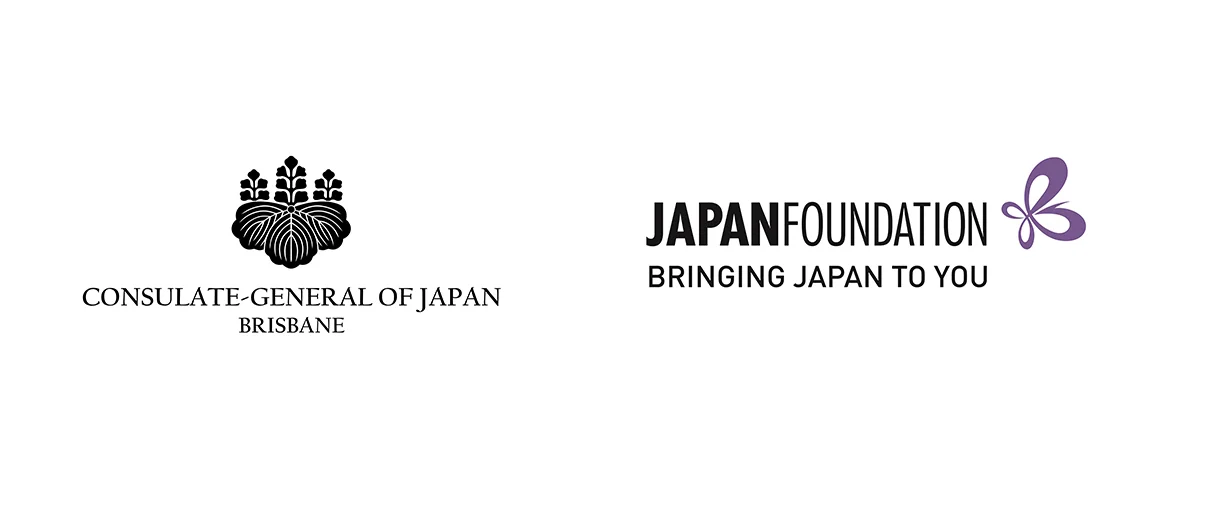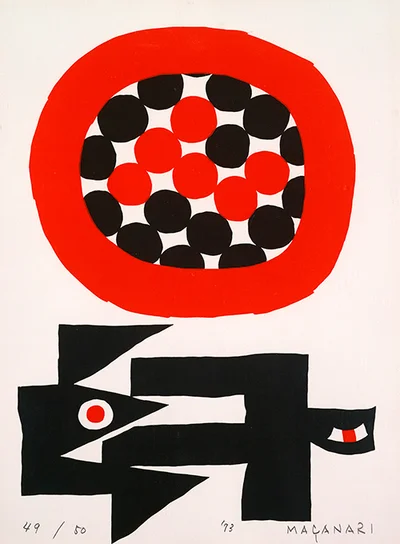Variation and Autonomy
The Prints of Contemporary Japanese Painters | 8 Dec 2023 to 21 Jan 2024
This exhibition, curated by Kyoji Takizawa from the print collection of the Machida City Museum of Graphic Arts, introduces the work of ten artists who explored a wide range of possibilities through prints and expanded the range of expression in contemporary art using the print medium in the 1970s.
The artists on show are Masanari Murai, Toshinobu Onosato, Yasukazu Tabuchi, Yayoi Kusama, Natsuyuki Nakanishi, Hitoshi Nakazato, Tomoharu Murakami, Naoyoshi Hikosaka, Kosai Hori, and Toeko Tatsuno.
Rather than focusing on print artists who are considered to have shaped the history of contemporary Japanese prints, the exhibition deals with prints by painters who drew on trends in contemporary art and attempts to reassess the existing history of contemporary Japanese prints.
This touring exhibition and catalogues, have been made possible by the Japan Foundation, Sydney and the Consulate-General of Japan, Brisbane.
| Location | Date and time |
| Caloundra Regional Gallery | 8 December 2023 to 21 January 2024 |
Artist profiles
Masanari Murai (1905-1999)
Born in Gifu Prefecture. After graduating from the Bunka Gakuin (Culture Institute) in 1928, Murai moved to France. Until returning to Japan in 1932, he traveled extensively in Europe as he produced paintings. Prior to World War II, while based in Tokyo, Murai became a pioneering abstract artist in Japan. After the war, he created deeply humanistic abstract paintings, using lines, planes, and colors to express people. Murai began devoting himself to print-making in the 1950s.
Toshinobu Onosato (1912-1986)
Born in Nagano Prefecture. Prior to World War II, Onosato’s paintings were marked by a Constructivist style with a tendency toward abstraction. He enlisted in the army following the outbreak of the Pacific War, but was later sent to a Siberian prison camp. After the war, he focused solely on geometrical paintings based on the theme of circles. In the late 1950s, Onosato began making lithographs, and in the 1960s, he switched to silkscreening, creating numerous print works.
Yasukazu Tabuchi (1921-2009)
Born in Fukuoka Prefecture. Tabuchi first began making paintings while studying art history at the University of Tokyo. In 1951, he moved to France to attend the Sorbonne. In 1953, Tabuchi officially began his career as an artist, engaging in a variety of creative activities while based in Paris. While considering the cultural origins that underlie between Europe and the East, he created oil paintings filled with an erotic air and rich colors. At the same time, Tabuchi produced and published collections of lithographs, copperplate engravings, and woodblock prints (some of these were poetry books).
Yayoi Kusama (born in 1929)
Born in Nagano Prefecture. Kusama began her career as an artist after moving to New York in 1957. In the 1960s, she showed soft sculptures based on themes such as sex and food while frequently organizing happenings. After returning to Japan in 1973, Kusama began publishing novels while continuing to make art. In 1979, she began expressing infinitely proliferating, dividing, linked, and diffused images in countless copperplate engravings, silkscreens, and lithographs.
Natsuyuki Nakanishi (1935-2016)
Born in Tokyo. Nakanishi graduated from the Western painting department at Tokyo University of the Arts in 1958. In the 1960s, he organized a variety of events on the street and in galleries, posing various questions about society with avant-garde art. Due to his friendship with the butoh dancer Tatsumi Hijikata, Nakanishi was also closely involved in creating stage sets and other props for butoh performances. He began focusing primarily on painting in the late 1960s, and in the 1970s, created oil paintings using white, purple, and yellowish green as key tones. He also produces silkscreens and copperplate engravings.
Hitoshi Nakazato (1936-2010)
Born in Tokyo. After graduating from Tama Art University in 1960, Nakazato enrolled in post-graduate art programs at the University of Wisconsin and the University of Pennsylvania from 1962 to 1968. Making paintings and prints while based in New York, Nakazato primarily showed his work in the United States and Japan. Limiting himself to elements like lines, geometrical forms, and colors, he produced work that explored the creation of images and illusions, and the relationship between painting and printmaking.
Tomoharu Murakami (born in 1938)
Born in Fukushima Prefecture. After graduating from the Japanese painting department at Tokyo University of the Arts in 1961, Murakami switched to oil painting. Then after seeing Abstract Expressionist works in the United States in 1964, he made a dramatic shift in direction. In 1979, he became a Catholic and began making paintings as a prayer to God. In addition to copperplate engravings, Murakami makes works by carving stone blocks, pouring ink over them, and repeatedly printing with the blocks.
Naoyoshi Hikosaka (born in 1946)
Born in Tokyo. After dropping out of Tama Art University in 1970, Hikosaka enrolled in a post-graduate program at the University of Pennsylvania as a special student in conjunction with the Agency for Cultural Affairs’ overseas study program. After returning to Tokyo, he primarily showed his work in a series of solo exhibitions. Hikosaka created “wood paintings,” in which he examined the relationship between painting and sculpture by evenly applying acrylic paint to wood plates. He has produced numerous prints using lithography, silkscreening, copperplate engraving, and woodblocks.
Kosai Hori (born in 1947)
Born in Toyama Prefecture. Hori dropped out of Tama Art University in 1970. While based in Tokyo, he primarily showed his work in solo exhibitions and participated in group shows in Japan and abroad, including the Paris Biennale and the Venice Biennale. While continually questioning the nature of painting, Hori makes pictures that combine acrylic, oil sticks, natural mineral pigments, and sumi ink. At the same time, he also creates silkscreen works.
Toeko Tatsuno (1950-2014)
Born in Nagano Prefecture. Tatsuno completed a post-graduate course at Tokyo University of the Arts in 1974. While studying printmaking at the school, she began to create silkscreen works in the style of minimal art. While based in Tokyo, she continued her creative activities, focusing primarily on oil painting, and showing her work in both solo and group exhibitions. Using geometrical forms and abundant colors to express shapes that are typically found in daily life, Tatsuno produced abstract paintings and prints based on unique spatial expressions.
 |
Featured

Masanari Murai | Sun and Bird | 1973
| silkscreen | 68 x 49cm | Image courtesy of the artist and the Japan Foundation
Summary
